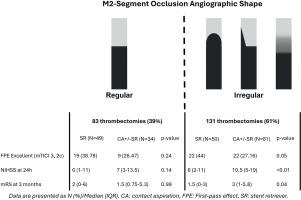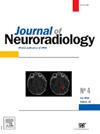机械取栓术中m2段闭塞血管造影形态对再通及临床结果的影响
IF 3.3
3区 医学
Q2 CLINICAL NEUROLOGY
引用次数: 0
摘要
背景:机械取栓治疗大脑中动脉m2段闭塞是治疗急性缺血性脑卒中的有效方法,但其有效性和一线策略的选择仍未得到解答。闭塞的血管造影形状被认为会影响m1段闭塞的再通率。我们的目的是研究血管成像的形状是否会影响支架回收器(SR)或接触吸入(CA)的MT结果。方法纳入2015年1月至2022年12月在同一家大容量医院连续收治的急性缺血性卒中m2段闭塞患者,并对其进行回顾性分析。根据血管造影闭塞形态将患者分为规则组和不规则组。回顾了患者的人口学、程序、临床和安全结局数据。结果共纳入214例MT手术,分为规则(39%)和不规则(61%)形状闭塞组。研究者间一致性高(k = 94%)。除吸烟外,两组在人口学、程序、临床和安全性方面均无显著差异(33.5% vs 16.8%, p = 0.01)。手术结果、再通率和临床结果在规则组和不规则组之间无显著差异。在亚组分析中,对于不规则闭塞,与CA±SR相比,SR作为一线策略在第一次通道后具有更高的优秀再通率(mTICI 2c - 3) (44% vs 27.16%, p = 0.05),并且具有更好的临床结果,24小时NIHSS较低(p <;3个月mRS较低(p = 0.04)。在常规闭塞情况下,使用SR或CA±SR在再通率和临床结果上无显著差异。结论选择SR作为不规则形状m2段闭塞的一线治疗策略,一遍通后再通率较高,临床效果较好。需要进一步的前瞻性研究来证实我们的发现。本文章由计算机程序翻译,如有差异,请以英文原文为准。

Impact of M2-segment occlusion angiographic shape on recanalization and clinical outcomes in mechanical thrombectomy
Background
Mechanical thrombectomy (MT) for M2-segment occlusions of the middle cerebral artery can be an effective treatment for acute ischemic stroke but its effectiveness and the choice of the first line strategy remains unanswered questions. The angiographic shape of the occlusion has been suggested to impact the recanalization rates in M1-segment occlusions. We aimed to investigate whether the angiographic shape of the M2-segment impacts the outcomes of MT with stent retriever (SR) or contact aspiration (CA).
Methods
From January 2015 to December 2022, consecutive patients admitted to a single high-volume institution for acute ischemic stroke with an M2-segment occlusion treated by MT were included and retrospectively analyzed. Patients were classified into two groups, regular or irregular, according to the angiographic occlusion shape. Patients demographic, procedural, clinical and safety outcomes data were reviewed.
Results
A total of 214 MT procedures were included and categorized as regular (39 %) and irregular (61 %) shape occlusion groups. Interrater agreement was high (k = 94 %). There were no significant differences between the two groups as regard demographic, procedural, clinical and safety outcomes except for smoking (33.5 % vs 16.8 %, p = 0.01). Procedural outcomes, recanalization rates and clinical outcomes did not significantly differ between the regular and irregular occlusion groups. In subgroup analysis, for irregular occlusions SR as a first-line strategy was associated with higher rates of excellent recanalization (mTICI 2c - 3) after the first pass compared to CA±SR (44 % vs 27.16 %, p = 0.05), and also better clinical outcomes, with lower 24-hour NIHSS (p < 0.01) and lower 3-month mRS (p = 0.04). In regular occlusions, no significant differences were found in recanalization rates or clinical outcomes when using SR or CA±SR.
Conclusion
Choosing SR as the first line strategy for irregular shape M2-segment occlusions is associated with higher rates of recanalization after the first pass and better clinical outcomes. Further prospective studies are needed to confirm our findings.
求助全文
通过发布文献求助,成功后即可免费获取论文全文。
去求助
来源期刊

Journal of Neuroradiology
医学-核医学
CiteScore
6.10
自引率
5.70%
发文量
142
审稿时长
6-12 weeks
期刊介绍:
The Journal of Neuroradiology is a peer-reviewed journal, publishing worldwide clinical and basic research in the field of diagnostic and Interventional neuroradiology, translational and molecular neuroimaging, and artificial intelligence in neuroradiology.
The Journal of Neuroradiology considers for publication articles, reviews, technical notes and letters to the editors (correspondence section), provided that the methodology and scientific content are of high quality, and that the results will have substantial clinical impact and/or physiological importance.
 求助内容:
求助内容: 应助结果提醒方式:
应助结果提醒方式:


